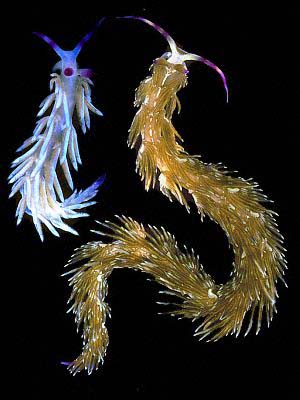
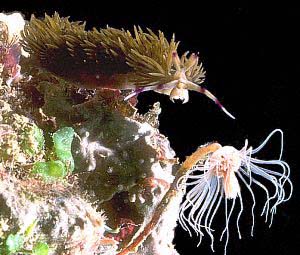
Pteraeolidia ianthina
(Angas,1864)
Order: NUDIBRANCHIA
Suborder: AEOLIDINA
Family: Glaucidae
DISTRIBUTION
Throughout the tropical and subtropical Indo-West Pacific.
PHOTO
Upper: White juvenile animal without symbiotic zooxanthellae and larger brown animal in which symbiotic zooxanthellae are nurtured in ducts of the digestive gland both in the cerata and the body wall. Lower: Adult Pteraeolidia feeding on the solitary hydroid Ralpharia which is its preferred adult food. Coffs Harbour Region, New South Wales, Australia, December 1990. Photos: Bill Rudman.
RELATED TOPIC
Pteraeolidia ianthina, commonly known as the 'Blue Dragon' by divers in eastern Australia, is one of a group of remarkable aeolid nudibranchs which are way ahead of man in harnessing solar energy. Pteraeolidia has evolved a method of capturing and farming microscopic plants (zooxanthellae) in its own body. The plants flourish in this protected environment and as they convert the sun's energy into sugars, they pass a significant proportion on to the nudibranch for its own use. The white animal is a juvenile which as not yet developed its crop of zooxanthellae. If this species is similar to others that have been studied then it must obtain its first "injection" of zooxanthellae by feeding on a hydroid with symbiotic zooxanthellae. White juveniles are usually found in lush growths of short "turfing" hydroids, but until now no sign of zooxanthellae has been found in the hydroids. Adults can last some time without feeding, presumably obtaining sufficient nourishment from their zooxanthellae gardens. The large solitary hydroid is the preferred adult food.
• See Yoshi Hirano's message about egg-laying.
-
Angas, G.F. (1864). Description d'espèces nouvelles appartenant à plusieurs genres de Mollusques Nudibranches des environs de Port-Jackson (Nouvelles-Galles du Sud), accompagnée de dessins faits d'après nature. Journal de Conchyliologie, 12: 43-70.
Rudman, W.B., 1998 (October 11) Pteraeolidia ianthina (Angas,1864). [In] Sea Slug Forum. Australian Museum, Sydney. Available from http://www.seaslugforum.net/find/pteriant
Related messages
Juvenile Pteraeolidia from Sabah, Malysia
November 23, 2009
From: Mirjam Broos
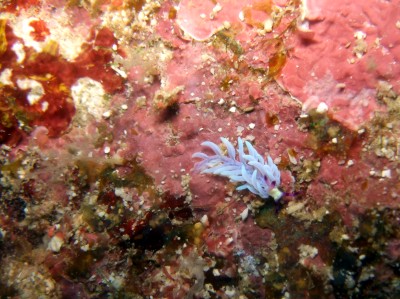
Hello Bill,
I can't find this slug in my identification books.To me it looks like Phyllodesmium.
Locality: Sipadan, Hanging garden, Sabah, Malaysia, 25 september 2009. Photographer: Geert Prast.
Can you help me out please.
Thanks again,
Mirjam
mirjam.broos@planet.nl
Broos, M., 2009 (Nov 23) Juvenile Pteraeolidia from Sabah, Malysia. [Message in] Sea Slug Forum. Australian Museum, Sydney. Available from http://www.seaslugforum.net/find/22829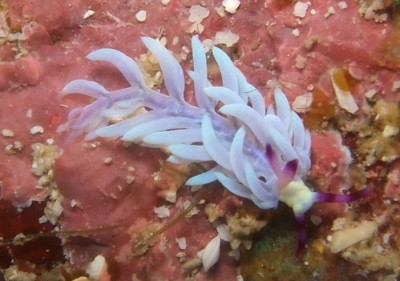
Dear Mirjam,
This is a juvenile Pteraeolidia ianthina. As we can see from Sully Bachel's message [#22228] adults show considerable variation in colour with some having tha very white colour form as in her message while others are shades of brown and purple. The brown ones all contain specialised branches of the digestive gland which contain microscopic brown algae [see Solar powered slugs] which they apparently obtain from their food hydroids. However juveniles lack these brown plant cells and so are white.
Best wishes,
Bill Rudman
Pteraeolidia ianthina from Reunion Island
November 23, 2009
From: Sully Bachel


Concerning message #13227:
Hello Bill
here is another white form color of Pteraeolidia ianthina found on an sandy edge in the spot "Cap La Houssaye" at St Paul
Locality: Cap la Houssaye, 8 m, Reunion Island, Indian Ocean, 27 September 2008. Length: 150 mm. Photographer: Sully Bachel.
best regards
sully bachel
s.bachel@orange.fr
Bachel, S., 2009 (Nov 23) Pteraeolidia ianthina from Reunion Island. [Message in] Sea Slug Forum. Australian Museum, Sydney. Available from http://www.seaslugforum.net/find/22228
Thanks Sully,
Best wishes,
Bill Rudman
Colour form of Pteraeolidia ianthina
October 29, 2008
From: Ann Clear
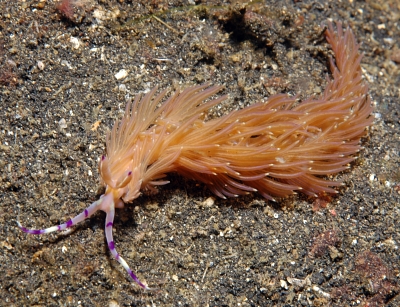
Hi Bill,
We have just returned from diving in the wonderful Lembeh Strait. I saw this nudibranch on my ascent, he was quite large and was moving very swiftly across the sandy bottom of a reef. I think it is of the Flabellinidae family, but have been unable to identify him. He was really lovely.
Locality: Lembeh Strait, 10 - 12 meters, Indonesia, Molucca Sea, 11 October 2006, Sandy Bottom. Length: 5 - 7 cms. Photographer: Ann Clear.
Thank you
Regards,
Ann Clear
ann.clear@btinternet.com
Clear, A, 2008 (Oct 29) Colour form of Pteraeolidia ianthina. [Message in] Sea Slug Forum. Australian Museum, Sydney. Available from http://www.seaslugforum.net/find/18970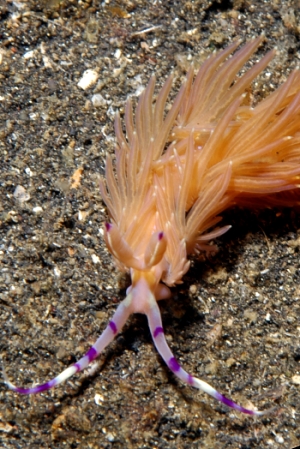
Dear Ann,
From the gemeral shape and colour of the head, this is clearly Pteraeolidia ianthina, but I must say I have never seen such a pale orange colour form like this before. As you will see from the Fact Sheet, adults usually have brown zooxanthellae in their bodies which gives them a dark brown colouration. Perhaps this one has lost its zooxanthellae?
Best wishes,
Bill Rudman
Pteraeolidia ianthina from Mayotte island
October 3, 2008
From: Eva Fontaine
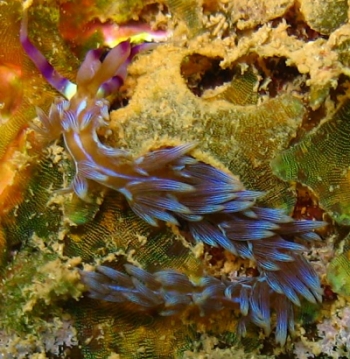
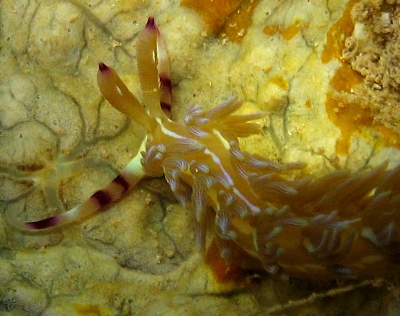
Concerning message #21884:
Dear Bill,
I found four specimens of this seaslug during my holidays in Mayotte island.
I think that it could be a particular form of Pteraeolidia ianthina with longitidinal blue stripes on the cerata.
Locality: M'titi, 2 m, Mayotte Island, Indian Ocean, July 2008. Length: 30 mm. Photographer: Eva Fontaine.
What's your opinion about this identification?
Best regards
Eva Fontaine
ev_f@hotmail.fr
Fontaine, E., 2008 (Oct 3) Pteraeolidia ianthina from Mayotte island. [Message in] Sea Slug Forum. Australian Museum, Sydney. Available from http://www.seaslugforum.net/find/21920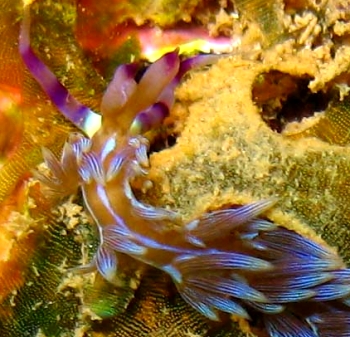
Dear Eva,
Thanks for these photos. This colour form, with fine bluish lines, is not very common, but Chikako's photo in Nishina Masayoshi's message [#4966] from Japan shows that this colour pattern is widespread.
Best wishes,
Bill Rudman
Pteraeolidia ianthina from Vanuatu
September 23, 2008
From: Leanne & David Atkinson
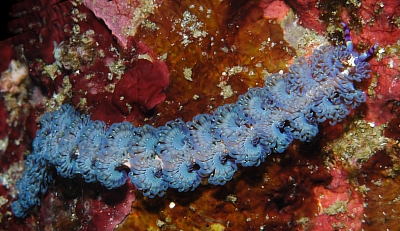
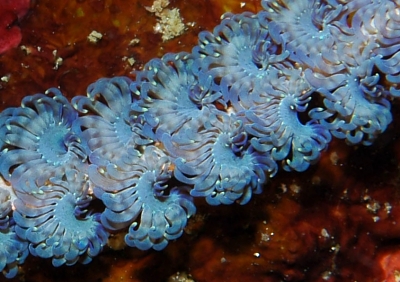
Concerning message #21780:
Hi Bill,
With all the discussion of Pteraeolidia ianthina recently we thought you might like to add some mature individuals from Vanuatu. These were both taken at the same dive site but on different days.
Locality: Gotham City, Mele Reef, Hideaway Island, 14metres, Vanuatu, Pacific, 15 April 2008 & 20 April 2008, Coral Reef. Length: 110 mm. Photographer: Leanne & David Atkinson.
As always thanks for your work on the Sea Slug Forum.
Leanne & David Atkinson
atk@hunterlink.net.au
Atkinson, L. & D., 2008 (Sep 23) Pteraeolidia ianthina from Vanuatu. [Message in] Sea Slug Forum. Australian Museum, Sydney. Available from http://www.seaslugforum.net/find/21903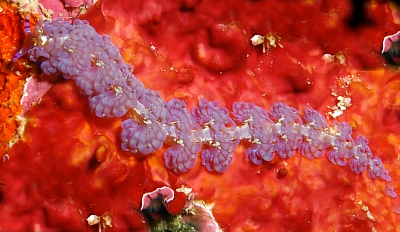
Thanks Leanne & David,
Best wishes,
Bill Rudman
Pteraeolidia ianthina from the Philippines
September 19, 2008
From: Jeffrey C. de Guzman
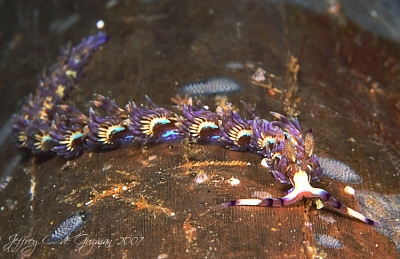
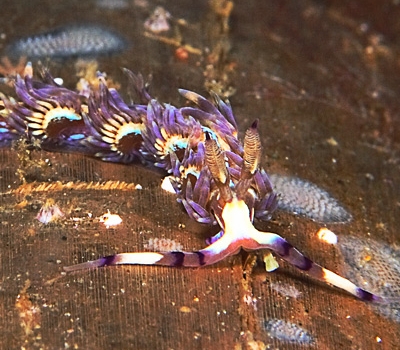
Here is a photo of Pteraeolidia ianthina.
Locality: Maiinit Anilao Batangas, 60 feet, Philippines, Philippines, 07 July 2007, Submerge Bamboo pole. Length: 5 inches. Photographer: Jeffrey C. de Guzman.
Jeffrey C. de Guzman.
jeffdeguzman@gmail.com
Mr., 2008 (Sep 19) Pteraeolidia ianthina from the Philippines. [Message in] Sea Slug Forum. Australian Museum, Sydney. Available from http://www.seaslugforum.net/find/20870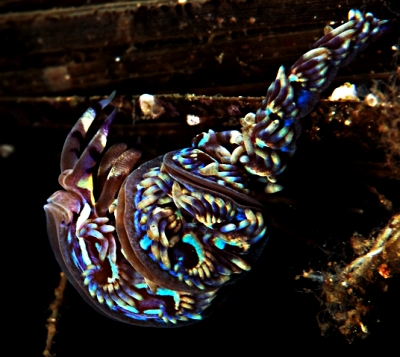
Dear Jeff,
The one in the upper photos looks like it may be eating the hydroids which are arranged in rows on the root-like stolons running over the bamboo.
Best wishes,
Bill Rudman
Pteraeolidia ianthina from Tonga
September 18, 2008
From: Marcel Tanke
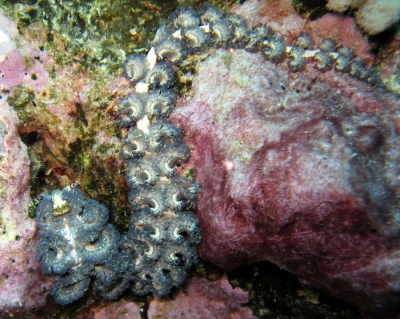
Concerning message #21739:
Dear Bill,
Just to share this Pteraeolidia ianthina from Tonga, wrapped around some sponge-covered rock, for your Forum.
15 m, Tonga, 17 October 2007. Length: 15 cm. Photographer: Marcel Tanke.
Best regards,
Marcel.
marceltanke@cs.com
Tanke, M.A., 2008 (Sep 18) Pteraeolidia ianthina from Tonga. [Message in] Sea Slug Forum. Australian Museum, Sydney. Available from http://www.seaslugforum.net/find/21780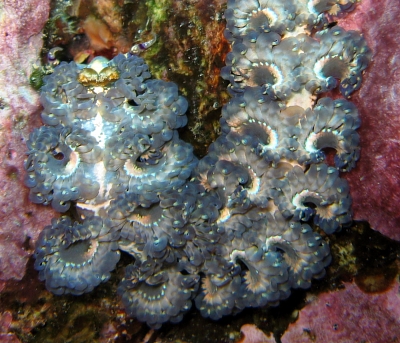
Thanks Marcel,
Best wishes,
Bill Rudman
Pteraeolidia ianthina from Fiji
September 18, 2008
From: Marcel Tanke
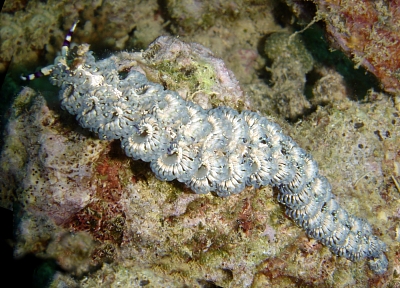
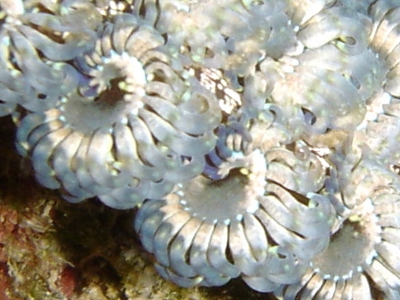
Concerning message #21739:
Dear Bill,
Just to share this large (12? cm) Pteraeolidia ianthina from Fiji for your Forum.
10 m, Fiji, Koro Sea, 29 April 2005. Length: about 12 cm. Photographer: Marcel Tanke.
Best regards,
Marcel.
marceltanke@cs.com
Tanke, M.A., 2008 (Sep 18) Pteraeolidia ianthina from Fiji. [Message in] Sea Slug Forum. Australian Museum, Sydney. Available from http://www.seaslugforum.net/find/21779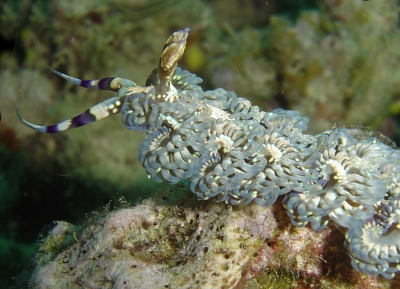
Thanks Marcel,
Best wishes,
Bill Rudman
Re: head of Pteraeolidia ianthina
September 16, 2008
From: Nicholas Missenden
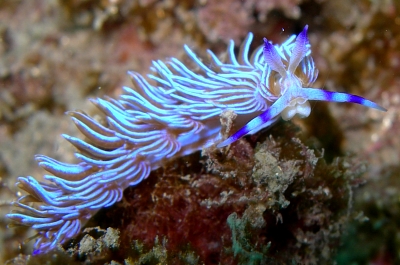
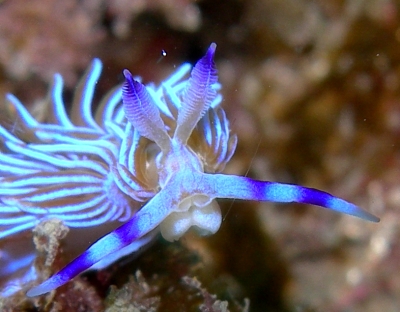
Hi Bill,
Just in relation to Erwin Kodiats' message on the rhinophores of the Pteraeolidia ianthina [#15742 ]. I have enclosed a picture that shows a very good head shot if you need one for your aeolid head Fact Sheet.
Locality: Bare Island, La Perouse, unknown, NSW, Australia, Botany Bay, 2005, Broken reef, sandy bottom. Length: unknown. Photographer: Nicholas Missenden
Regards
Nick
Thanks Nick,
Bill Rudman
Rudman, W.B., 2008 (Sep 16). Comment on Re: head of Pteraeolidia ianthina by Nicholas Missenden. [Message in] Sea Slug Forum. Australian Museum, Sydney. Available from http://www.seaslugforum.net/find/15778Photos of Pteraeolidia ianthina
September 16, 2008
From: Sukhdev Singh
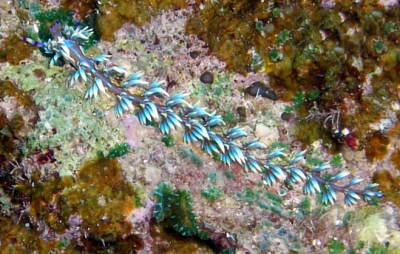
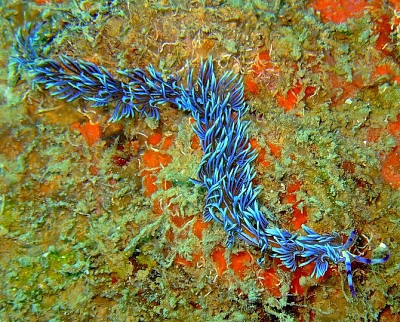
Hi,
I just thought you might like to see my 'Blue Dragon' pics.
The first is one a friend emailed to me & I believe he took it in the Philippines. The second one I took at Lankayan Island, North Borneo.
The last was taken at Sipadan Island, Borneo. It's a still from the video I had made.
Locality: Island, 15 metres, Borneo, South China Sea, 13 June 2007, Reef wall. Length: 4 inches. Photographer: Sukhdev Singh.
Sukhdev Singh
suk@suksreef.com
Singh,S., 2008 (Sep 16) Photos of Pteraeolidia ianthina. [Message in] Sea Slug Forum. Australian Museum, Sydney. Available from http://www.seaslugforum.net/find/21884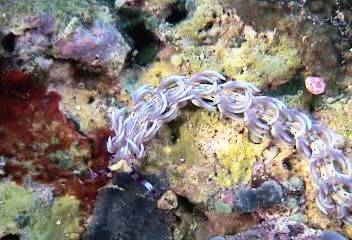
Dear Suk,
Thanks for these photos. When I see photos like this of one animal with short cerata and the other with long ones, it makes me think there must be more than one species. But I have looked at the anatomy of a whole series of animals from all parts of the world and can find no obvious differences. Perhaps DNA studies will suggest there is more than one species, but then again maybe the differences are physiological - perhaps to do with the symbiotic zooxanthellae they harbour. I have a few more messages on this species to post. I will do it today or sometime soon.
Best wishes,
Bill Rudman
Pteraeolidia ianthina: looks like something everted
August 13, 2008
From: Roland Bircher
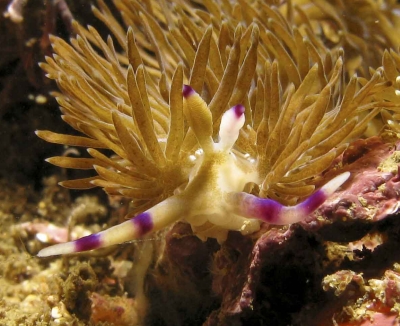
Dear Bill,
Recently on a dive at Bare Island I photographed what I think is a Pteraeolidia ianthina. Between the upper and lower photos it looks like the nudibranch is everting something. Is this the oral tube as you mention in an earlier answer or am I completely wrong?
Locality: Bare Island, La Perouse, Sydney, 10 m, Australia, Botany Bay, 19 July 2008, Bay, overgrown rock. Length: 10 cm. Photographer: Roland Bircher.
Kind regards,
Roland
roland.bircher@gmx.net
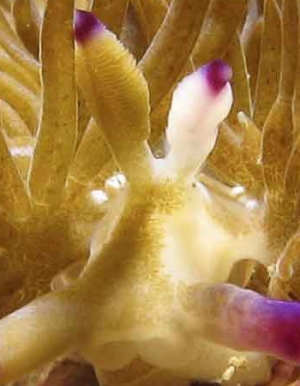
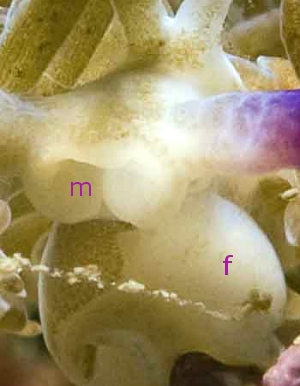
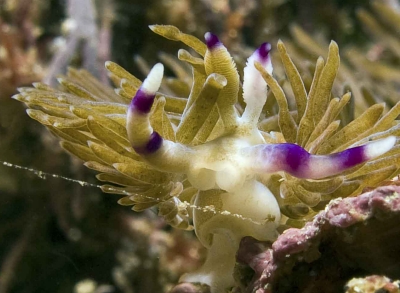
Dear Roland,
As you will see from the species Fact Sheet, Pteraeolidia is a solar powered species relying on the energy produced by the microscopic plants it 'farms' in its body. The brown spotting and branching you can see in the two close-ups of the head, are clusters of these plants [zooxanthellae] in branches of the digestive system. For some reason, your animal lacks these branches of the digestive system on the left side of its face and foot, and in its left rhinophore. This could be a developmental fault or it could be that this part of the body has been damaged - perhaps bitten off - and has regrown without the digestive gland ducts.
Now that I have 'set the scene' I hope I can answer your anatomical question. The mouth is situated between the two large oral tentacles. It is a bit further back than the m I have added to the photo but if the oral tube was everted it would be over the top of the 'm'. I have put an 'f ' where something seems to be being everted. This is in fact the left side of the anterior foot. Because it is bright white, it seems to be sticking out more than on the other side, which still has the brown of the digestive system. I hope that makes sense.
Best wishes,
Bill Rudman
Pteraeolidia ianthina from the Philippines
July 28, 2008
From: Carrie Lo
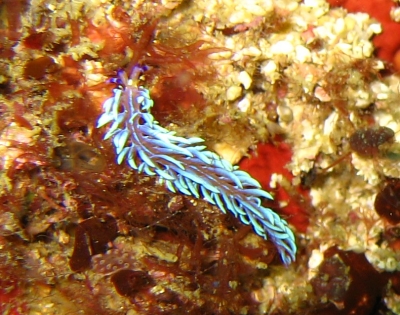
Dear Bill,
Could this be one of the Phyllodesmium serratum? I cannot match it to your gallery.
Locality: Malapascua, Gato Island, 20 m, Philippines, 29 Dec 2006. Length: 2 cm. Photographer: Carrie Lo.
Cheers,
Carrie
carrielohc@yahoo.com.hk
Lo, C., 2008 (Jul 28) Pteraeolidia ianthina from the Philippines. [Message in] Sea Slug Forum. Australian Museum, Sydney. Available from http://www.seaslugforum.net/find/21739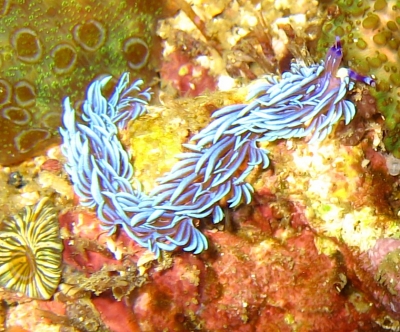
Dear Carrie,
This is Pteraeolidia ianthina, one of the amazing solar powered aeolids. Have a look at the Fact Sheets for more information.
Best wishes,
Bill Rudman
Pteraeolidia ianthina (?) from Mozambique
September 20, 2007
From: Natasja Vandeperre
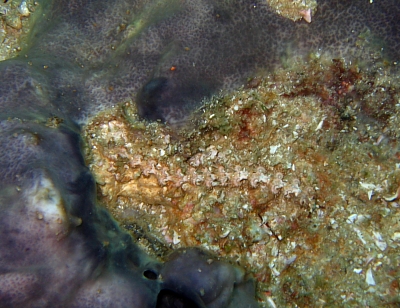
Hello Bill,
My closest guess to this one is Pteraeolidia ianthina. But I'm not convinced. On the second picture you can see eggs. Are these from this species?
Locality: Tofo, Mozambique, Indian Ocean, 22 July 2007. Length: 100mm. Photographer: Natasja Vandeperre.
Greetings,
Natasja
postmaster@naaktslakken.be
Vandeperre, N., 2007 (Sep 20) Pteraeolidia ianthina (?) from Mozambique. [Message in] Sea Slug Forum. Australian Museum, Sydney. Available from http://www.seaslugforum.net/find/20580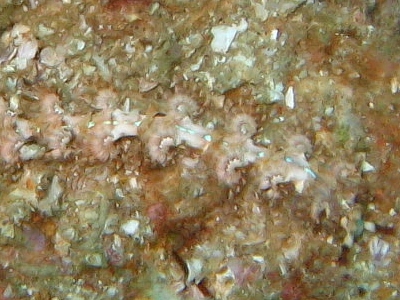
Dear Natasja,
Firstly I couldn't see any eggs in your second photo so I have included a close-up showing the front half of the animal a bit more clearly. This certainly falls into the group I am calling Pteraeolidia ianthina. I am not entirely convinced that all the animals you can see in the Forum messages are one species, but many years ago when I was first interested in solar powered species I dissected a whole range of different coloured animals, some with relatively short cerata like your animal and others with longer cerata, but could find no consistent differences in anatomy or radular morphology. There are names that have been given to different body shapes but there seems little point in using them unless we can define which is which.
Best wishes,
Bill Rudman
Pteraeolidia ianthina from Port Noarlunga, SA
January 16, 2007
From: Stephen J. Reynolds
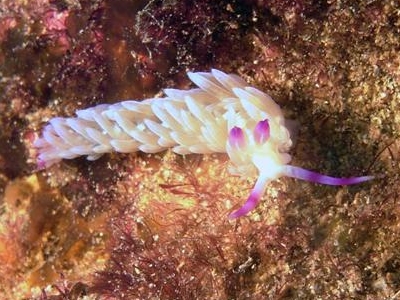
Concerning message #19105:
Dear Bill
Thanks for the Hypselodoris saintvincentius ID.
I have another one for you, a Flabellina sp. from Port Noarlunga reef in 2006.
Locality: Port Noarlunga reef, SA, Ocean, 18 June 2006. Photographer: Paul Macdonald.
Cheers
Steve
stever@sdfsa.net
Reynolds, S.J., 2007 (Jan 16) Pteraeolidia ianthina from Port Noarlunga, SA. [Message in] Sea Slug Forum. Australian Museum, Sydney. Available from http://www.seaslugforum.net/find/19208Dear Steve,
This is the a solar-powered sea slug - Pteraeolidia ianthina. Its white colour suggest it has not yet started to farm zooxanthellae in its body, so I presume it is quite young.
Best wishes,
Bill Rudman
New feeding record for Pteraeolidia ianthina
December 5, 2006
From: Bruce Wilkie
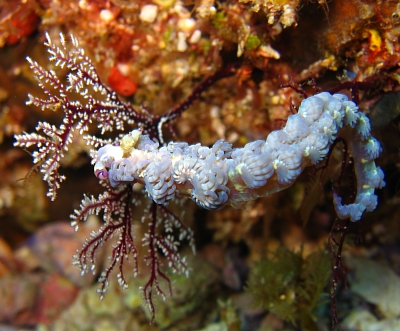
Concerning message #18378:
Hi Bill,
Thought you may be interested in these photo`s of Pteraeolidia ianthina feeding on a hydroid (possibly the sea fir Solanderia fusca). I watched this animal for about 10 mins, it must have been rather hungry because it attacked the sea fir with great ferocity.
Locality: Flat Rock North Stradbroke Island, 8 metres, Queensland Australia, Pacific ocean, 02 November 2006, rocky reef with sponges, hard & soft corals . Length: long. Photographer: Bruce Wilkie.
Many Thanks,
Bruce Wilkie.
brucedwilkie@yahoo.com.au
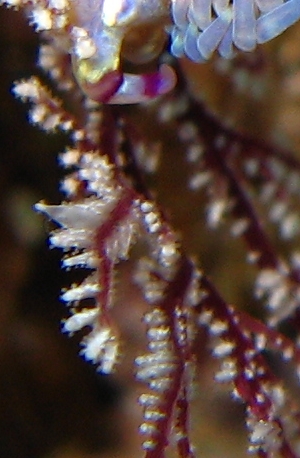
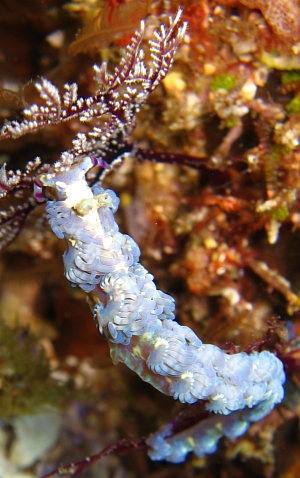
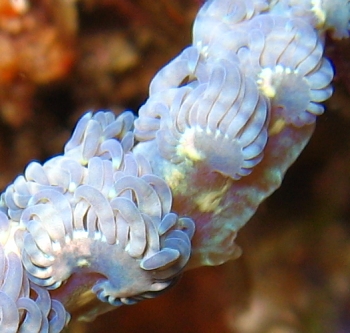
Dear Bruce,
I am definitely very interested in what this amazing solar-powered sea slug feeds on. As you will know from the Fact Sheet, the only hydroid we know Pteraeolidia feeds on is the solitary tubularian hydroid Ralpharia. However since Ralpharia doesn't have zooxanthellae its been a mystery as to where the aeolid gets its zooxanthellae from. Pteraeolidia also seems to have at least two 'forms' this very elongate form with compact ceratal groups and a shorter form with much longer cerata. So any new information on its biology is very welcome.
This hydroid certainly looks like a species of Solanderia but as far as I know Solanderia does not have symbiotic zooxanthellae in its tissues. Mind you, the very pale colour of the Pteraeolidia suggests it may be lacking zooxanthellae as well. You have added another piece to the puzzle - I can't say it has solved anything but I hope it reignites some enthusiasm for us all to try and find more about its biology.
Best wishes,
Bill Rudman
Pteraeolidia ianthina from Sipadan trip
July 21, 2006
From: Charles Rowe
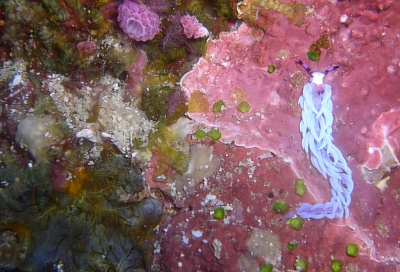
Hi Bill,
This is the fourth of a series of nudis from my trip to Sipadan which I would like you to identify and comment on. This nudi was tiny and we had problems focussing on it but I think I did quite a good job.
Locality: Sipadan Island, 15metres, Malaysia, 29 April 2006, reef. Length: 8 mm. Photographer: Charles Rowe.
Charles Rowe
bumff@mweb.co.za
Rowe, C., 2006 (Jul 21) Pteraeolidia ianthina from Sipadan trip. [Message in] Sea Slug Forum. Australian Museum, Sydney. Available from http://www.seaslugforum.net/find/16850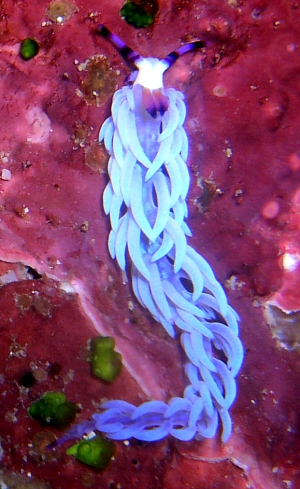
Dear Charles,
This is a solar-powered nudibranch, Pteraeolidia ianthina. You may be more familiar with it in its dark brown colour phase, but the white phase is an indication that its 'battery is flat'. If you look at the solar-powered Fact Sheet you will see that these nudibranchs store live single-celled plants [zooxanthellae] in their bodies - which gives them their brown colour - but we are not sure where they get the plants from in the first place. All juveniles are white like this, and they stay white until they start to grow zooxanthellae in their bodies.
Best wishes,
Bill Rudman
Pteraeolidia ianthina from Bali
July 13, 2006
From: Kevin Lee
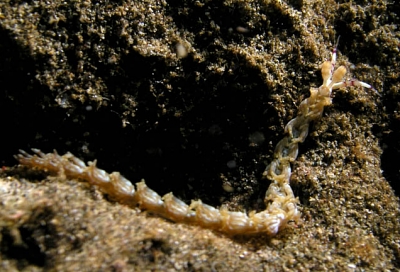
Doc,
And, what might this critter be?
Locality: Ahmed, approx 20 feet, Bali, Indoneisa, Indo Pacific (Java Sea), 06 June 2006, rocky/sandy bottom. Length: approx. 2+ inches. Photographer: Kevin Lee.
K:-)
diverkevin@gmail.com
Lee, K., 2006 (Jul 13) Pteraeolidia ianthina from Bali. [Message in] Sea Slug Forum. Australian Museum, Sydney. Available from http://www.seaslugforum.net/find/16929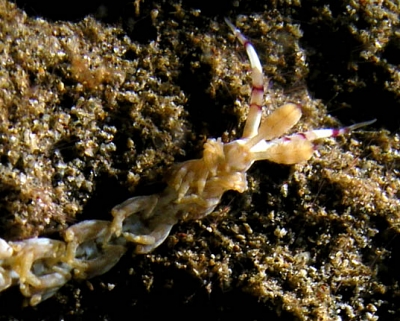
Dear Kevin,
This is one of my favourite solar-powered nudibranchs, Pteraeolidia ianthina. Have a look at the Fact Sheet, and earlier messages, for lots of information on this fascinating species
Best wishes,
Bill Rudman
Re: Closer look at Pteraeolidia ianthina's head
June 3, 2006
From: Carol Yin
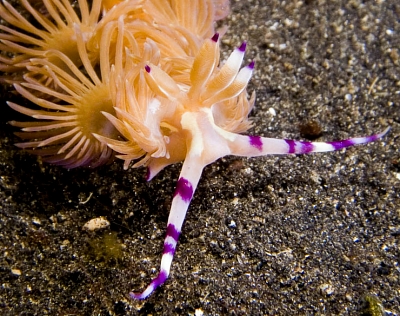
Concerning message #15742:
Hello, Bill,
Does this Pteraeolidia ianthina have four rhinophores??
Locality: Hairball, 30 ft, N. Sulawesi, Indonesia, N. Sulawesi. Length: 7 inches. Photographer: Carol Yin.
Thank you :).
Carol Yin
carolyin@yahoo.com
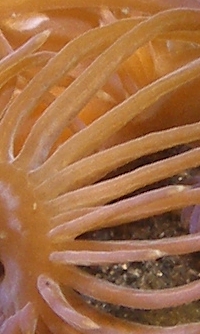
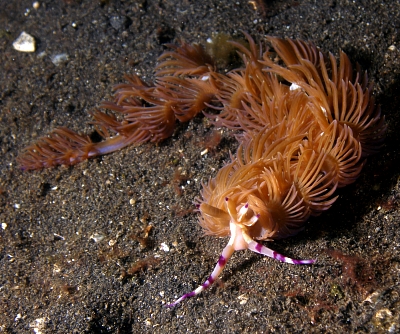
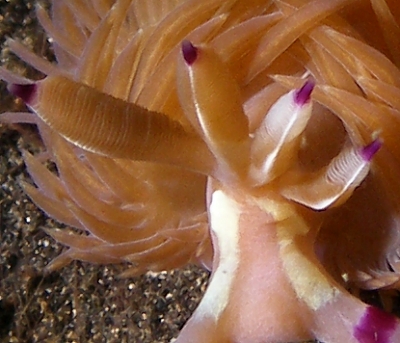
Dear Carol,
It does indeed. Sometimes if the animal sustains an injury, then mistakes can occur during regrowth, but it looks to me that something went wrong during its development. I'll add it to the page on abnormal development.
One other interesting thing is the very pale uniform colour of this animal. Pteraeolidia keeps microscopic plants alive in its body [see solar powered sea slugs] and usually they give the animal a darker colour than this. In the close up of some of the cerata I can see no sign of the plants, which appear as small brown specks, so it is possible its pale colour is because it has lost its symbiotic plants.
Best wishes,
Bill Rudman
Closer look at Pteraeolidia ianthina's head
February 7, 2006
From: Erwin Kodiat
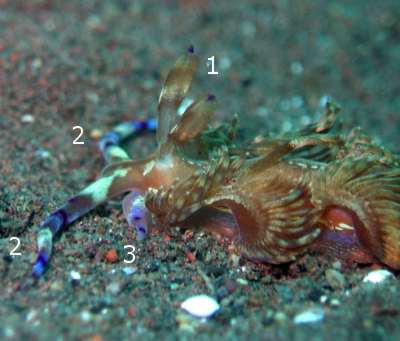
Hi Bill,
Just took a closer head shot of Pteraeolidia ianthina, it made me realize that the rhinophores are actually the brown one and not the bright one which I guess it is its radula, please correct me if I'm wrong.
Locality: Seraya, Bali, Indonesia, Lombok Strait. Depth: 17 meters. Length: 15 cm. 29 January 2006. Sandy bottom. Photographer: Erwin Kodiat
Erwin Kodiat
ungu@terong.com
Kodiat, E., 2006 (Feb 7) Closer look at Pteraeolidia ianthina's head. [Message in] Sea Slug Forum. Australian Museum, Sydney. Available from http://www.seaslugforum.net/find/15742Dear Erwin,
When I get a moment I'll do an aeolid head Fact Sheet to match the Dorid head Fact Sheet. In the meantime I have numbered the 'tentacles' in your photo.
1. rhinophores - chemosensory ['smelling' organs]
2. oral tentacles - tactile [touching] organs which are perhaps also chemosensory.
3. anterior foot corner - the anterior edge of the foot is sometimes rounded and sometimes has angular corners. Sometimes these corners are relatively long and tentacular, as in Pteraeolidia.
The radula is essentially an internal organ which is soemtimes partly everted like a rasping tongue during feeding. If anything is everted during feeding, it is the oral tube and part of the buccal bulb, which is the muscular structire just inside the mouth which contains the radula -see photo of Geitodoris planata [#5126] with partly everted buccal bulb.
Best wishes,
Bill Rudman
Nudibranch - The Blue Dragon
February 2, 2006
From: Aisha. E
I'm new and never have been to this site. I'm doing a class project on the blue dragon (nudibranch). Does anybody have any information, pictures, websites, etc. Anything that you may think that might help me I would greatly appreciate.
(This animal doesn't seem to have a lot of infomation from what I've found)Aisha. E
fallen_deathangel2342@yahoo.com
Aisha. E, 2006 (Feb 2) Nudibranch - The Blue Dragon. [Message in] Sea Slug Forum. Australian Museum, Sydney. Available from http://www.seaslugforum.net/find/15682Dear Aisha,
Have a look at my answer to an earlier question [#6999]. One problem is that common names like 'blue dragon' aren't used very widely, and even when they are they can meam different things to different people. In future use the Forum search facility. Check out the two species I mention in my earlier answer, there is quite a lot of information on both species - dont forget to look at the related messages attached at the bottom of each Fact Sheet
Best wishes,
Bill Rudman
Re: I need Pteraeolidia ianthina
December 13, 2005
From: Makiko Yorifuji
I'm a graduate student working on the life history of Pteraeolidia ianthina under Dr. Yoshiaki Hirano. Please give Yoshi my regards. I've just read the message about P. ianthina dated Oct. 4, 2005 [#14917 ] and I'd like to share some of my findings on this sea slug with you.
First, I've seen P. ianthina crawling or staying on/near Myrionema amboinense in the field (Okinawa, Japan). I've confirmed that P. ianthina eats M. amboinense in the laboratory. Second, I found many kinds of nematocysts probably derived from many hydroids in the cnidosacs of the slug. Prey hydroids of this slug I've confirmed so far include Tubularia, Eudendrium spp., Halocordyle disticha, in addition to M. amboinense. This slug may even eat some other cnidarians. When I gave a species of swimming anemone to hungry slugs of P. ianthina (those kept without food for about 3 months) on trial, some of them ate the sea anemone. Also I've seen a slug of P. ianthina biting a stauromedusa (Stenoscyphus inabai) in a small container in which a student was keeping these two animals together for a few hours after collecting. So, I think P. ianthina has a wide spectrum of food as an adult. Moreover, as they can survive for about a half year only with light (no prey), they may not eat Myrionema so frequently.
Besides, I'm cautious about selling and/or buying sea slugs for a personal hobby. I don't think using P. ianthina to get rid of Myrionema hydroids is a good idea.
Makiko Yorifuji
yorifuji@graduate.chiba-u.jp
Yorifuji, M, 2005 (Dec 13) Re: I need Pteraeolidia ianthina. [Message in] Sea Slug Forum. Australian Museum, Sydney. Available from http://www.seaslugforum.net/find/15453Dear Makiko,
Thanks for this interesting information. I remember Dr Hirano mentioning he had a graduate student studying Pteraeolidia. Certainly in northern New South Wales, adult Pteraeolidia are associated with the solitary tubularian hydroid Ralpharia, but that is not to say in more tropical waters, as you have discovered, that it can potentially feed on a wider variety of cnidarians. What greatly interests me is where it gets its zooxanthellae from? At some early stage in its life cycle it must feed on a cnidarian with zooxanthellae. Have you found a potential source of zooxanthellae?
I also am uncomfortable with the idea of catching and selling Pteraeolidia as possible biological control agents in aquaria.
Best wishes,
Bill Rudman
Re: I need Pteraeolidia ianthina
October 6, 2005
From: Albert Jeffers
Re: message #14917: That's horrible news. Do you have any idea if there is an animal that eats this stuff?
Albert Jeffers
acidbaby@bellsouth.net
Jeffers, A., 2005 (Oct 6) Re: I need Pteraeolidia ianthina. [Message in] Sea Slug Forum. Australian Museum, Sydney. Available from http://www.seaslugforum.net/find/14929Sorry Jeff,
No idea
Bill Rudman
I need Pteraeolidia ianthina
October 4, 2005
From: Albert B Jeffers
I have a problem with Myrionema hydroids in my reef tank. I have succcesfully controlled other organisms with the use of certain slugs, through the kind advice of you guys on this forum. I need to purchase Pteraeolidia ianthina from somewhere, I don't care where and have no problem with money when it comes to saving my extensive collection of corals.
I fully understand the hazards of keeping zooxanthellate bearing slugs in a coral tank and I am willing to pick them out after the job is done and pass them on to fellow aquarists with the same problem.
If my only option is to get them from a research facility or school, I will be glad to furnish pictures and written observation of my attempt.
Albert Jeffers (squeezix on reefcentral)
Vero Beach, Florida, USA
acidbaby@bellsouth.net
Jeffers, A.B., 2005 (Oct 4) I need Pteraeolidia ianthina. [Message in] Sea Slug Forum. Australian Museum, Sydney. Available from http://www.seaslugforum.net/find/14917Dear Jeff,
I'm afraid you seem to have missed the point that most nudirbranchs have very specialised diets. Those with zooxanthellae symbiosis certainly don't eat all cnidarians with zooxanthellae, they eat only one or a few closely related species. Most zooxanthellae zymbionts get their zooxanthellae not from hard corals, but from either soft corals or sea anemones. Pteraeolidia, as you'll see from the Fact Sheet, is an exception./ It eats hydroids as an adult, but only some solitary hydroids related to Tubularia which don't have zooxanthellae. They apparently get their zooxanthellae from some unknown small hydroid as juveniles. The point I am trying to make is that there is no evidence that they eat Myrionema.
This is the reason that keeping nudibranchs in aquaria is a bad idea. Most have very specialised diets. Just because you hear that dorid nudibranchs eat sponges, it doesn't mean you can throw in any sponge and think any dorid will eat it. Similarly Pteraeolidia is so fussy we don't even know what it eats as a juvenile and as an adult it certainly doesn't eat Myrionema.
Best wishes,
Bill Rudman
Pteraeolidia ianthina from Malaysia
September 10, 2005
From: Umut Tural

Dr. Bill Rudman
This photo was taken last year during our dive trip to Sipadan Kapalai. Among the many beautiful & interesting creatures, the only one we did very curious about it, very long worm or nudibranch, we couldnt figure out What it is. What do you think , Could be a nudibranch ? We would be very glad if you help us identification of this creature.
Locality: Sipadan Kapalai, Malaysia. Depth: 12 m. 24 January 2004. Photographer: Aydin K1_1nbay
Thank you.
Umut Tural
umuttural@hotmail.com
Tural, U,, 2005 (Sep 10) Pteraeolidia ianthina from Malaysia. [Message in] Sea Slug Forum. Australian Museum, Sydney. Available from http://www.seaslugforum.net/find/14693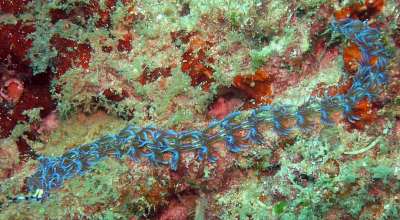
Dear Umut,
This spectacular worm-like animal is a nudibranch. It is the solar-powered aeolid Pteraeolidia ianthina. Whether there is more than one species needs further study. I have examined animals from throughout the Indo-West Pacific and can find no anatomical difference or difference in the shape of their teeth. The only difference is that some animals are very long like this and others are much shorter, although even the relatively short ones can greatly extend in length when crawling. I must say it's a major problem when trying to post a photo of the whole animal.
Pteraeolidia ianthina is one of a variety of nudibranchs and sacoglossans which can be called 'solar-powered' because they keep plant cells, or plant organelles, alive in their tissues to photosynthesise. Have a look at the relevant Fact Sheets for more information.
Best wishes,
Bill Rudman
Pteraeolidia ianthina from West Malaysia
June 2, 2005
From: Ho Wei Kwok Alvin
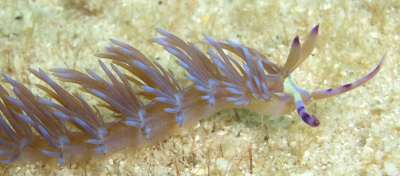
Hi Bill,
Here is another slug, Pteraeolidia ianthina, found at Dayang Jetty, Pulau Dayang.
Locality: Dayang Jetty, Pulau Dayang, West Malaysia. South China Sea. Depth: 5 m. Length: 20-30 mm. 2 May 2005. Sand Bottom, Rubble. Photographer: Alvin Ho.
Regards,
Alvin
howeikwok@hotmail.com
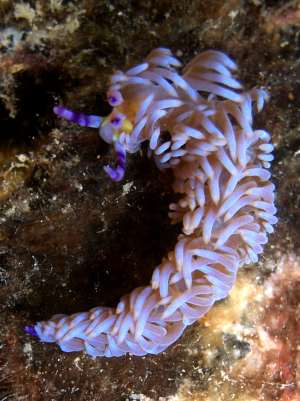
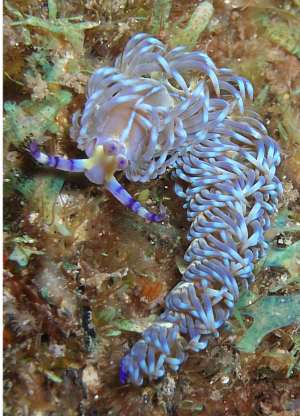
Thanks Alvin,
I guess you have read about this solar powered nudibranch.
Best wishes,
Bill Rudman
Pteraeolidia ianthina from Reunion Island
March 1, 2005
From: Philibert Bidgrain
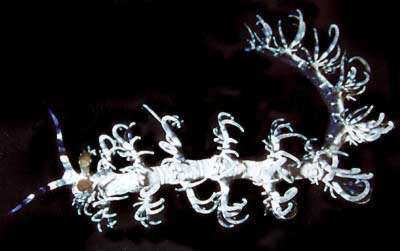
Dear Bill,
Reunion Island sea slugs.
We have this specimen, observed by Maurice Jay, a white color form of Pteraeolidia ianthina, found in "La Saline" lagoon, under a rock. Reunion Island, Indian ocean. Photographer: Maurice Jay
Best Regards
Philibert Bidgrain
http://vieoceane.free.fr/runseaslug/indexslug.htm
pbidgrain@yahoo.fr
Bidgrain, P., 2005 (Mar 1) Pteraeolidia ianthina from Reunion Island. [Message in] Sea Slug Forum. Australian Museum, Sydney. Available from http://www.seaslugforum.net/find/13227Thanks Philibert,
Best wishes,
Bill Rudman
Pteraeolidia ianthina from Bali
February 23, 2005
From: Rainer Mau
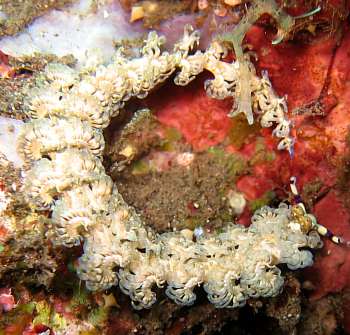
Hi Bill,
Another one I have recently seen in Balinese waters. I suspect it's a Pteraeolidia, but.....
I assume you can help me
Locality: Alam Anda, Bali, Indonesia, Java sea. Depth: 7 m. Length: 9 cm. 20.December 2004. below huge rock, close to shorerline. Photographer: Rainer Mau
Cheers
Rainer
rainer.mau@hansenet.de
Mau, R., 2005 (Feb 23) Pteraeolidia ianthina from Bali. [Message in] Sea Slug Forum. Australian Museum, Sydney. Available from http://www.seaslugforum.net/find/13109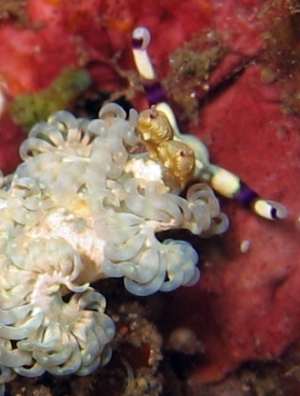
Dear Rainer,
Yes this is Pteraeolidia ianthina. It's a shame that because the animal is so long it is hard to post a big enough photo to show its beauty, which is in the detail. I have included a close-up alongside of the head to show some of the spectacular colouration and the way the cerata are arranged on large plate-like, rounded bases
Best wishes,
Bill Rudman
Thank you
December 31, 2004
From: Toshiko Tani
Dear Dr Bill Rudman,
Thank you very much for answering my question about a creature we saw in the Beqa Lagoon, Fiji [#12851] - which you told us was Pteraeolidia ianthina! I read all of the related messages on Pteraeolidia ianthina you cited and your answer to each of the messages. Yes, they do indeed seem to vary in colors and sizes. Also thank you for educating us for how the adult forms feed themselves by hosting many microscopic plants in their bodies!! Such an interesting creature!!!
It is wonderful that such a forum on sea slugs is available on-line to gather/share the information where even an non-academic sea creature lover like myself can learn so much.
Thank you again for your kind reply to my question and I thank Australian Museum, too, for running such a good website.
P.S. I am still such a beginner diver and not relaxed enough to handle a camera in the water. The photo of the Pteraeolidia ianthina was taken by my friend Yoko who loves sea creatures, too.
Sincerely,
Toshiko Tani
Tokyo, Japan
toshiko.tani@db.com
Toshiko, T., 2004 (Dec 31) Thank you. [Message in] Sea Slug Forum. Australian Museum, Sydney. Available from http://www.seaslugforum.net/find/12850Dear Toshiko,
As you will see on the Forum, there are many beautiful and interesting sea slugs in Japan, and a whole group of divers interested in them. I hope this is only the first of many messages from you
Best wishes,
Bill Rudman
Sea Slug or Centipede?
December 30, 2004
From: Toshiko Tani
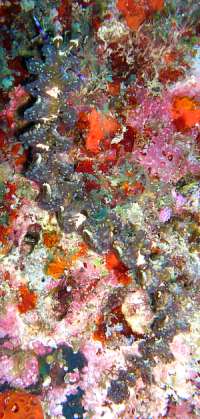
My friend and I saw a creature in the attached photo when we were diving near Beqa Island, Fiji, in the middle of December 2004. We went through pages of sea slug information available on the Net to identify what it was but have not had any luck. Could someone in this forum kindly tell us what this is. It may not even be a sea slug but something else...
Locality: 30 minutes by a boat toward the northwest of Beqa Island, Fiji. Depth: 15 metres. Length: 150mm. December 18, 2004. Photo: Yoko Morimoto.
Toshiko
toshiko.tani@db.com
Toshiko, T., 2004 (Dec 30) Sea Slug or Centipede?. [Message in] Sea Slug Forum. Australian Museum, Sydney. Available from http://www.seaslugforum.net/find/12851Dear Toshiko,
This is indeed a sea slug. It is the nudibranch Pteraeolidia ianthina. As you will see on the species' Fact Sheet it is one of a very interesting group of nudibranchs which we have called solar-powered because they have many microscopic plants living in their bodies which provide them with sugars and other nutrition. Pteraeolidia is often found like this extended out in the sunlight so the plants in its body can use the sun's energy to photosynthesise. Have a look at Matthias Huerlimann's message [#12820 ] for a photo of a juvenile.
It certainly looks like a centipede, and one of the early names for this species was Flabellina scolopendrella because the French scientist who found it thought it looked like a centipede, [scolopendre = centipede in French]. Have a look at the many other messages on the page. Some of the photos will give you a good idea of the size and shape of this animal.
Best wishes,
Bill Rudman
Juvenile Pteraeolidia ianthina from Philippines
December 30, 2004
From: Matthias Huerlimann
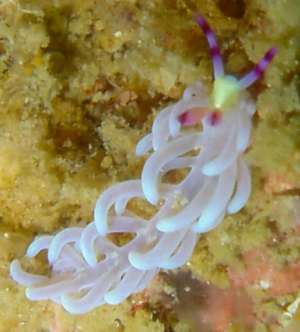
Dear Bill
I found this little nudibranch 2 weeks ago on the Philipines and I was looking for hours now in the internet, but I am not sure if this is a juvenile Pteraeolidia ianthina. Maybe you can help me?
Locality: Pandan Island (occ. Mindoro), Philippines, South China Sea
Depth: ca. 10 m. Length: ca. 10 mm. 6 December 2004
Photographer: Matthias Huerlimann
p.s. your site is just great!
Merry Christmas
Matthias
matthiashuerlimann@yahoo.com
Huerlimann, M., 2004 (Dec 30) Juvenile Pteraeolidia ianthina from Philippines. [Message in] Sea Slug Forum. Australian Museum, Sydney. Available from http://www.seaslugforum.net/find/12820Dear Matthias,
Yes this is Pteraeolidia ianthina. Juveniles are white like this because they have not as yet, obtained the zooxanthellae which give them the brown colour of adults. See the Fact Sheets on solar-powered animals to see how they use the zooxanthellae.
Best wishes,
Bill Rudman
Pteraeolidia ianthina from Sth Africa
February 21, 2004
From: Riaan Marx
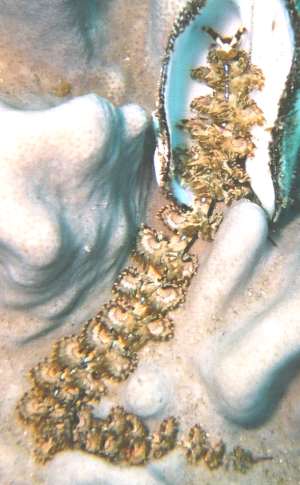
Hi Bill.
I photographed this animal at Sodwana, [KwaZulu-Natal] South Africa.
Could you help me identify it please?
Thanks!
Riaan
rmarx@ms.cs.co.za
Marx, R., 2004 (Feb 21) Pteraeolidia ianthina from Sth Africa. [Message in] Sea Slug Forum. Australian Museum, Sydney. Available from http://www.seaslugforum.net/find/12263Dear Riaan,
This is Pteraeolidia ianthina. Have a look at the species Fact Sheet to learn something about this remarkable 'solar powered' slug.
Best wishes
Bill Rudman
Juvenile Pteraeolidia ianthina
February 1, 2004
From: Frank Weber
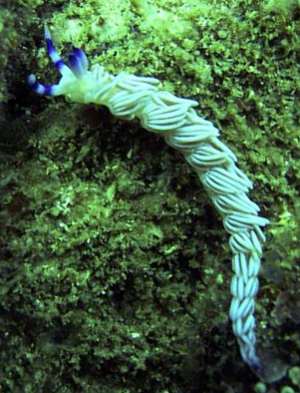
Dear Bill,
Could you please tell me what this is. I took the photo at Merimbula, southern New South Wales, [Australia] in 15 m of water in September 2003.
It was about 3 cm long. Any help would be gratefully accepted.
Frank Weber
frank.w@pacific.net.au
Weber, F., 2004 (Feb 1) Juvenile Pteraeolidia ianthina. [Message in] Sea Slug Forum. Australian Museum, Sydney. Available from http://www.seaslugforum.net/find/12061Dear Frank,
This is a young Pteraeolidia ianthina. Have a look at the species' Fact Sheet where I explain how they change from white to brown as they begin to nurture single-celled plants in their bodies.
Best wishes
Bill Rudman
Pteraeolidia ianthina from Indonesia
January 30, 2004
From: Dana Africa
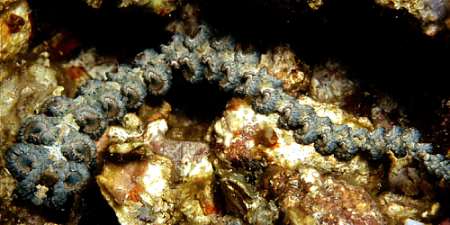
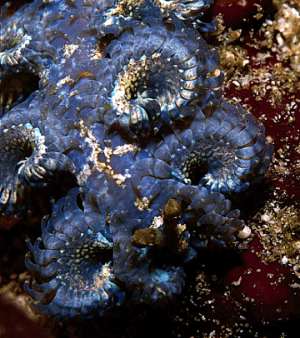
Dear SeaSlug Forum
While scuba diving between Komodo Island and Alor Island in the Indonesian chain, I came across this nudibranch twice. Have never seen it before and cannot find it in my ID books. It is about 20 cm long. I enclose two photos - one of the whole body and one of the head.
Best wishes
Dana Africa
AfriDiver@aol.com
Africa, D., 2004 (Jan 30) Pteraeolidia ianthina from Indonesia. [Message in] Sea Slug Forum. Australian Museum, Sydney. Available from http://www.seaslugforum.net/find/12056Dear Dana,
This is Pteraeolidia ianthina. Have a look at the species Fact Sheet and other messages on the Forum to get an idea of its varaibility and solar powered life style.
Best wishes
Bill Rudman
Pteraeolidia ianthina laying eggs - Nelson Bay
December 20, 2003
From: Dave Harasti
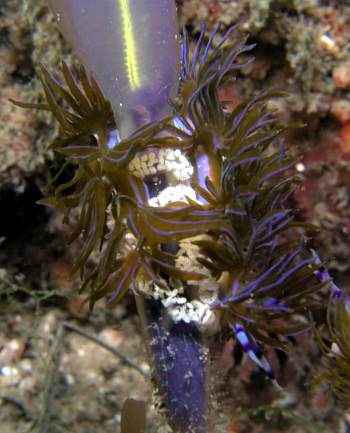
Hi Bill,
On Dec 18th 2003 I found Pteraeolidia ianthina laying eggs on a yellow-lined ascidian. This was at Fly Point - Nelson Bay, NSW, Australia. depth was about 12 metres.
cheers,
Dave
www.daveharasti.com
diving@webone.com.au
Harasti, D., 2003 (Dec 20) Pteraeolidia ianthina laying eggs - Nelson Bay. [Message in] Sea Slug Forum. Australian Museum, Sydney. Available from http://www.seaslugforum.net/find/11718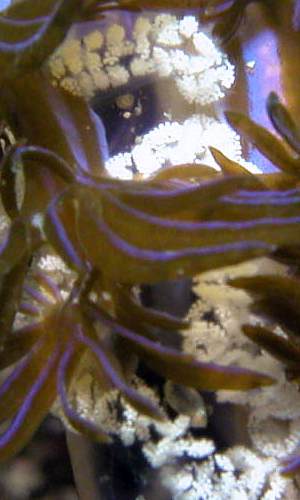
Thanks Dave,
Pteraeolidia has a habit of staying near its eggs. Whether this is just coincidence or a genuine brooding behaviour is not known, but if you are back at the spot in the next week or so it might be worth checking
Best wishes
Bill Rudman
Pteraeolidia ianthina from Malaysia
May 24, 2003
From: Asther M. Lau
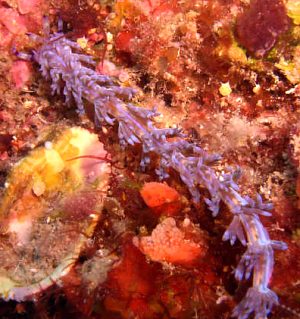
Hi again,
Had found tonnes of this seaslug in East Coast of Malaysia. is it a Blue Dragon? Realised that this species likes to hang-out on wrecks and boulders. Also, it comes in brown, blue, black and even silver colors!
This pic was taken recently during my trip to Tenggol Is.
Date: 25th April 2003
Location: Moon Raker, Tenggol Is. Malaysia
Depth: 16m
Size: 6.5cm
Asther M. Lau
asther@scubadiveknit.com
Lau, A.M., 2003 (May 24) Pteraeolidia ianthina from Malaysia. [Message in] Sea Slug Forum. Australian Museum, Sydney. Available from http://www.seaslugforum.net/find/9822Dear ASther,
Yes this is Pteraeolidia ianthina, often called the 'Blue Dragon'. It is one of the few examples of a common name which seems to be quite common. I don't know if you have looked at the Fact Sheet for this species. If you do you will see that it is one of the the solar-powered species which rely on sunlight to keep the plants in its body healthy.
Best wishes,
Bill Rudman
Pteraeolidia ianthina with eggs
April 5, 2003
From: Leanne & David Atkinson
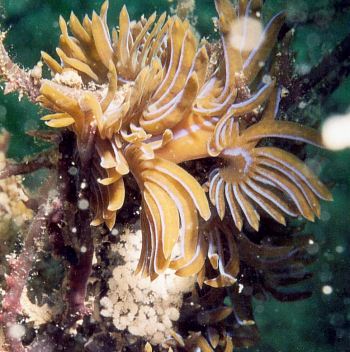
Dear Bill,
After seeing Mary Jane Adams shots of Pteraeolidia ianthina mating we checked out the rest of the Pteraeolidia ianthina pages on the site. In your message with Akos' photo with eggs you talked about them laying on boulders and guarding the eggs. We recently photographed this one with eggs on a common plant/algae. Sorry about the quality of the photo, it was surgy with a sandy bottom and poor viz. The plant was swaying badly even when held. We tried hard not to disturb her/him. It was well wrapped around the eggs and difficult to get a clear shot.
Fly Point, Port Stephens, NSW, Australia
Depth: 8 meters. 11 January 2003
Time: 15.23, high tide 1.22m
Temp: 21 degrees C.
Leanne & David Atkinson
atk@hunterlink.net.au
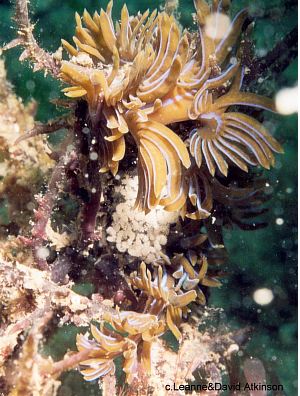
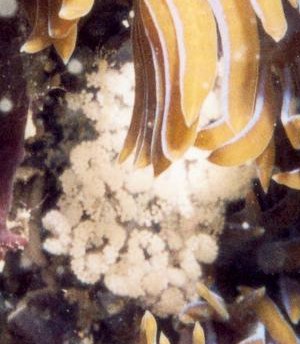
Thanks Leanne & David,
I've included 3 versions of your photo to show the egg ribbon in detail and the rather unusual flattened looking cerata. This species seems to be quite variable both in shape and length of the cerata.
Best wishes,
Bill Rudman
Pteraeolidia ianthina mating
March 25, 2003
From: Mary Jane Adams
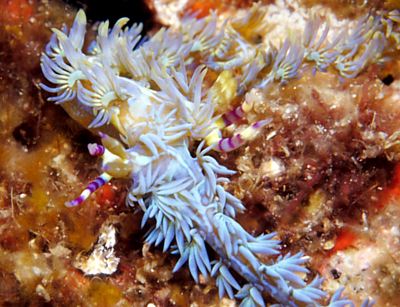
Hi Bill,
I photographed these two Pteraeolidia ianthina mating in the Similan Islands, Andaman Sea, Thailand on March 2, 2003. The divesite is called Elephant Head Rock. The depth was 5 meters. There were numerous P.ianthina on the vertical faces of several house-size boulders on this divesite. I saw them from the intertidal region to about 10 meters. They were all the same lavender color which appears purple underwater. The smaller ones were pale pastel and the larger ones deeper shades.
Best regards,
Mary Jane
divepng@yahoo.com
Adams, M.J., 2003 (Mar 25) Pteraeolidia ianthina mating. [Message in] Sea Slug Forum. Australian Museum, Sydney. Available from http://www.seaslugforum.net/find/9405Thanks Mary Jane,
They are spectacular animals.
Bill Rudman
Pteraeolidia ianthina from North Sulawesi
October 13, 2002
From: Marli Wakeling
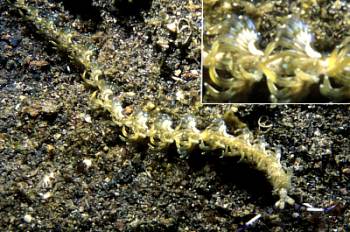
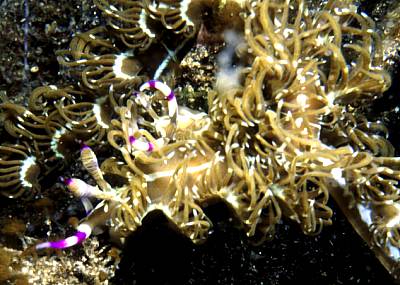
Hi Bill,
Here are two photos of Pteraeolidia ianthina from Lembeh Straight, from two different sites. There were lots of these around, often in tangled groups.
Location: Photo 1: Police pier, Photo 2: Hairball, Lembeh Straight, Sulawesi, Indonesia
Date: July 2002
Depth: 45 feet
Length: 15 - 20 cm.
Photographs: Marli Wakeling
Regards,
Marli
scubamarli@excite.com
Wakeling, M., 2002 (Oct 13) Pteraeolidia ianthina from North Sulawesi. [Message in] Sea Slug Forum. Australian Museum, Sydney. Available from http://www.seaslugforum.net/find/8129Thanks Marli,
These are fascinating animals. They have been observed in New South Wales, clustering in groups, and apparently 'guarding' their egg masses. They were certainly make an interesting Ph D thesis or two.
Best wishes,
Bill Rudman
Pteraeolida ianthina from Red Sea
September 27, 2002
From: Michael Mrutzek
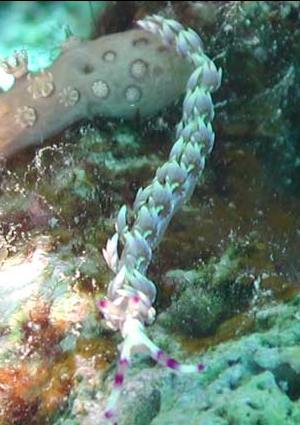
Dear Bill,
Here is a photo of another slug from the Red Sea for use in the Forum.
Data: Stone Beach, Hurghada, Red Sea coast of Egypt, August, 2002, 20 meters. Photo: Copyright Michael Mrutzek
Michael
Mrutzek@meeresaquaristik.de
Mrutzek, M., 2002 (Sep 27) Pteraeolida ianthina from Red Sea. [Message in] Sea Slug Forum. Australian Museum, Sydney. Available from http://www.seaslugforum.net/find/8034Dear Michael,
This is Pteraeolidia ianthina. It is an extremely interesting aeolid because it stores microscopic plants in its body. See the Solar powered slugs page for further information.
Best wishes,
Bill Rudman
Juvenile Pteraeolidia ianthina? from Tioman
July 31, 2002
From: Maliza Anuar
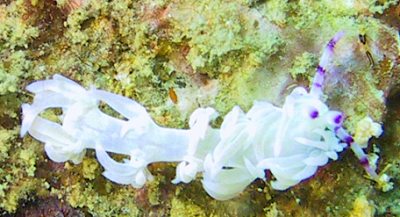
Bill,
This photo was taken at Tioman Island, off the east coast of Malaysia. Dive Site: Labas, 24 June 2002, 11:13am
Depth: 15-18m, Size: 5-7cm
This gorgeous little thing sure looks like a juvenile Pteraeolidia ianthina.
Maliza Anuar
emaliza@hotmail.com
Anuar, M., 2002 (Jul 31) Juvenile Pteraeolidia ianthina? from Tioman. [Message in] Sea Slug Forum. Australian Museum, Sydney. Available from http://www.seaslugforum.net/find/7519Dear Maliza,
It is indeed a juvenile Pteraeolidia ianthina.
Best wishes,
Bill Rudman
Pteraeolidia ianthina? from Tioman
July 30, 2002
From: Maliza Anuar
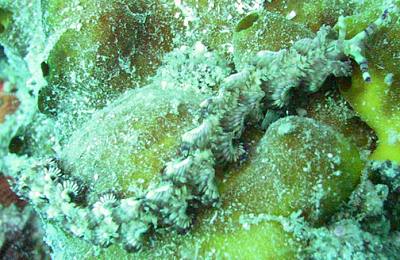
Bill,
This photo was taken at Tioman Island, off the east coast of west Malaysia.
Dive Site: Soyak Island, 23 June 2002, 4:40pm
Depth: 12m
Size: my husband swears it was at least 10cm
I've browsed around the species list and this guys looks like a Pteraeolidia ianthina. We saw quite a few of these (abt 3 per dive) in Tioman. I thought the brown coloring was kind of "boring" but after reading on how these guys are solar powered, I'll definitely be taking a closer look next time.
Maliza
emaliza@hotmail.com
Anuar, M., 2002 (Jul 30) Pteraeolidia ianthina? from Tioman. [Message in] Sea Slug Forum. Australian Museum, Sydney. Available from http://www.seaslugforum.net/find/7517Dear Maliza,
Yes this is Pteraeolidia ianthina. And I am sure 10 cm was not an exaggeration.
Bill Rudman
Pteraeolidia from Tioman, Malaysia
July 16, 2002
From: Maliza Anuar
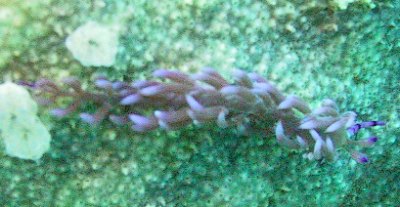
Bill,
Could you help ID this little guy? Photo was taken by my husband on our recent diving trip to Tioman Island off the east coast of Malaysia.
Dive Site: Soyak Island, 4:30pm
Depth: 13-15m
Size: 5-6cm
Maliza Anuar
emaliza@hotmail.com
Anuar, M., 2002 (Jul 16) Pteraeolidia from Tioman, Malaysia. [Message in] Sea Slug Forum. Australian Museum, Sydney. Available from http://www.seaslugforum.net/find/7473Dear Maliza,
This is Pteraeolidia ianthina. Have a look at the Fact Sheet on this species for more information on its 'solar-powered' lifestyle.
Best wishes,
Bill Rudman
Pteraeolidia ianthina from Philippines
June 2, 2002
From: Stewart L. Sy
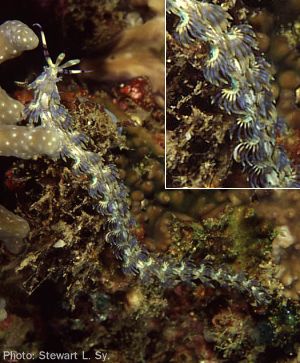
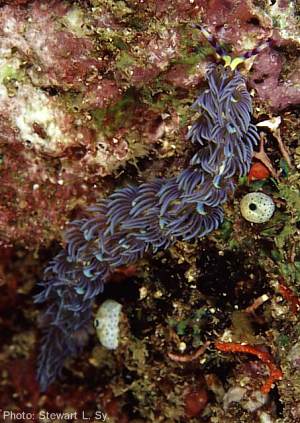
Hi,
These photos were taken in Puerto Galera, on the island of Mindoro in the Philippines. The dive site is called Sinandigan Wall. Depth of 60 feet and the animals are about 2 inches in length.
I wasn't sure what species this is, but from my very limited knowledge, I assumed it to be some form of Flabellina.
thanks!
Stewart
stewart@scan-conversions.com
Sy, S.L., 2002 (Jun 2) Pteraeolidia ianthina from Philippines. [Message in] Sea Slug Forum. Australian Museum, Sydney. Available from http://www.seaslugforum.net/find/7052Dear Stewart,
This is Pteraeolidia ianthina, which you will see from the two pages of messages is quite variable in shape and colour and is found throughout the tropical and subtropical Indo-West Pacific.
Best wishes,
Bill Rudman
Pteraeolidia from Papua New Guinea
October 10, 2001
From: Marli Wakeling

Hi Bill,
This is a difficult one for me to figure out. This seems to possibly be some sort of Bornella, but it blended in so well with its' surroundings.
Perhaps you can help solve the mystery!
Location: Nusa Blowholes, Kavieng, Papua New Guinea
Depth: 10 metres
Length: 6 cm.
Photograph: Marli Wakeling
Marli
scubamarli@excite.com
Wakeling, M., 2001 (Oct 10) Pteraeolidia from Papua New Guinea. [Message in] Sea Slug Forum. Australian Museum, Sydney. Available from http://www.seaslugforum.net/find/5370Dear Marli,
This part of the 'complex' we call Pteraeolidia ianthina. Have a look at the many messages and photos we have on this 'species'. The difference in size of cerata varies considerably and you can find all variants together. The shapes and colour forms seem to intergrade and I suspect individuals can change the shape of the cerata. I can't find any anatomical or radula differences.
Cheers,
Bill Rudman
Pteraeolidia ianthina from NE Sulawesi
September 22, 2001
From: Jim Anderson
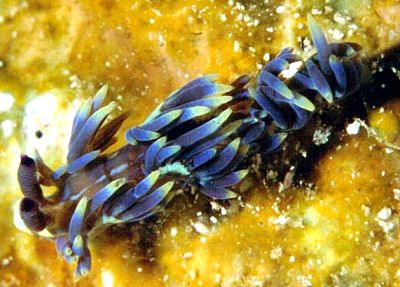
Dear Dr. Rudman,
Another from Sulawesi, Indonesia.
Found this Pteraeolidia ianthina at 7 m on Banks Island dive site Tanjung Sepia on 25 June. It was approx 30 mm long.
Kind regards,
Jim Anderson
jander4454@aol.com
Anderson, J., 2001 (Sep 22) Pteraeolidia ianthina from NE Sulawesi. [Message in] Sea Slug Forum. Australian Museum, Sydney. Available from http://www.seaslugforum.net/find/5012Thanks Jim,
Bill Rudman
Pteraeolidia ianthina from Sagami Bay
August 23, 2001
From: Nishina Masayoshi
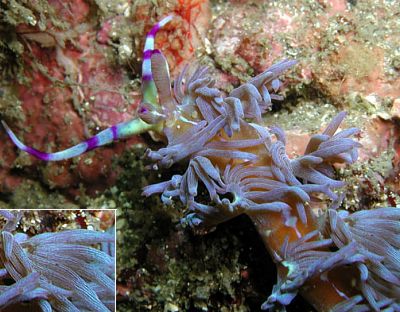
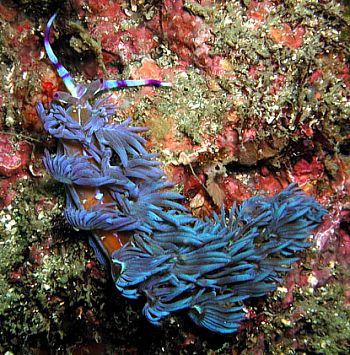
Dear Dr.Rudman,
I often find Pteraeolidia ianthina here but this is big animal for me.
Date: 14 July 2001
Place: Enoura Beach, Sagami Bay, Japan
Depth: 5m
Size: 50mm
Comment: Common here
Photo by Nishina Chikako.
Best Regards,
Nishina Masayoshi
nishina@hpe15.wips.co.jp
Nishina, M., 2001 (Aug 23) Pteraeolidia ianthina from Sagami Bay. [Message in] Sea Slug Forum. Australian Museum, Sydney. Available from http://www.seaslugforum.net/find/4966Dear Nishina,
Thanks to you and Chikako for these photos of the marvellous 'Solar-powered Sea Slug' Pteraeolidia. I have included an inset showing the lines of little brown specks in the cerata, which are the single-celled plants (zooxanthellae) which live in special ducts in the body wall and photosynthesise to provide nourishment for the nudibranch as well as the plants.
Best wishes,
Bill Rudman.
Pteraeolidia ianthina from Indonesia
December 24, 2000
From: Yasman
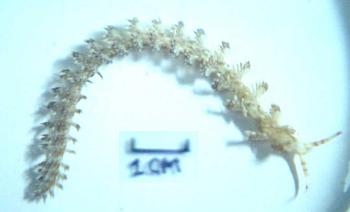
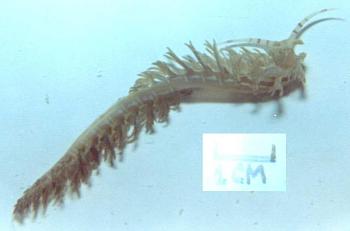
Dear Bill,
This is one of the species (Pteraeolidia ianthina) I found in Karang Lebar Atoll, Thousand Islands, Indonesia. This species is quite common found in that area. It is found at depth of 40-80 feets, crawling either on sponge or sandy substrate.
Regards,
Yasman
y.yasman@mailcity.com
Yasman, Y., 2000 (Dec 24) Pteraeolidia ianthina from Indonesia. [Message in] Sea Slug Forum. Australian Museum, Sydney. Available from http://www.seaslugforum.net/find/3329Dear Yasman,
Thanks for the record. It seems you have both extremes in sahpe and colour, the upper photo being a brownish animal with relatively short cerata and the lower one more bluish, with relatively long cerata. I was beginning to think the only animals you found were species of the Phyllidiidae.
Bill Rudman.
Pteraeolidia - brooding eggs
June 2, 2000
From: Akos Lumnitzer
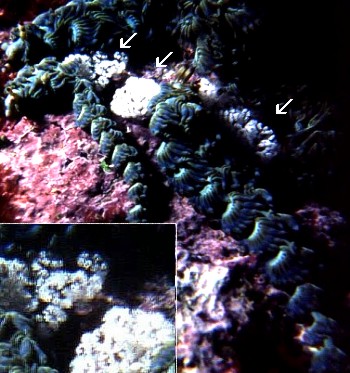
Hi Bill .... again!
I may be blind, but there don't seem to be any Pteraeolidia ianthina on the Forum. Have they been renamed?
I believe there could be two distinct species; one, the bluey purple colour form, with very evenly spread out cerata and the dull, brown-grey ones with bunched cerata. Could that be a possibility?
Here are three photos from around Sydney [New South Wales, Australia] for you.
UPPER RIGHT: Shark Pt, Clovelly in 16m.
LOWER LEFT: Kurnell in 12 m of water.
LOWER RIGHT: North Head, Port Jackson in 20m water. Animal is about 10cm long
Regards
Akos
dna72@softhome.net
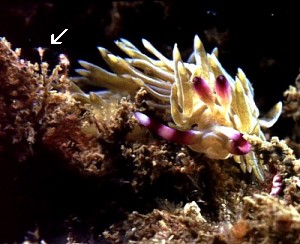
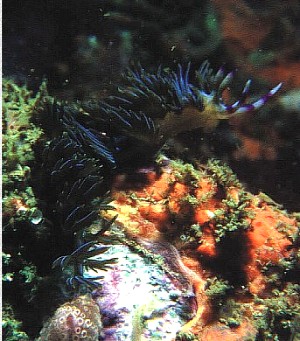
Dear Akos,
Far be it for to comment on your sight but there are two pages for Pteraeolidia ianthina on the Forum. Now that the Species List is getting so large a good way to find species is to use the SEARCH button at the top and bottom of every page.
The different shapes and colours found in Pteraeolidia certainly suggest the possibility of more than one species but I have looked at material from all around the Indo-West Pacific and can't find even one consistent anatomical character to separate them. One reason for the colour differences, and perhaps the length of the cerata, relates to their symbiosis with photosynthetic plant cells (zooxanthellae) which is described on Page 1 and on the Solar powered nudibranch Page. Also look at the messages on those pages and below yours on this page.
One particularly interesting phenomenon you have captured in the upper right photo is the habit of this species to cluster in groups around a collection of egg masses which I have arrowed and enlarged in the inset. All observers who have seen this phenomenon in New South Wales find them on the exposed tops of large submerged boulders in 10-15 meters. The boulders are usually covered in encrusting coralline algae (which shows there is enough light for photosynthesis) and the group of Pteraeolidia usually stay with the egg masses for at least 2-3 weeks. At this size they are feeding on the large solitary hydroid Ralpharia sp. so they must either leave the egg masses at night to feed some distance away, starve, or else rely on the products of photosynthesis.
Thanks for the interesting photos. The bottom left photo shows an intermediate sized animal by a colony of colonial hydroids on which it is possibly feeding.
Best wishes,
Bill Rudman.
White Pteraeolidia ianthina from South Africa
March 10, 2000
From: Valda Fraser
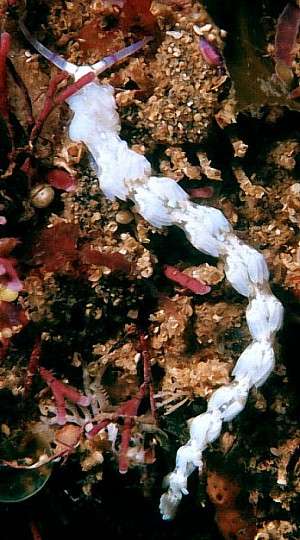
Dear Bill
I have not been able to identify this nudibranch. Can you help!
Locality: South Coast KwaZulu-Natal, South Africa. Pumula - near Port Shepstone - 18m
Date: March 1999
Size: 26mm
Regards
Valda Fraser
iti04937@mweb.co.za
Fraser, V., 2000 (Mar 10) White Pteraeolidia ianthina from South Africa. [Message in] Sea Slug Forum. Australian Museum, Sydney. Available from http://www.seaslugforum.net/find/2052Dear Valda,
This is the white form of Pteraeolidia ianthina. You will see from my comments above that this is one of the Solar-powered nudibranchs which 'farm' one-celled plants in their bodies. However they have to obtain these brownish plant cells (zooxanthellae) after they have settled out of the plankton. Before they find them they are this translucent white colour. Usually they find zooxanthellae by the tine they reach about 10-15mm in length so your animal is apparently having difficulty finding a supply of zooxanthellae.
Best wishes,
Bill Rudman.
Pteraeolidia ianthina from Hawaii
December 22, 1999
From: Anne Dupont
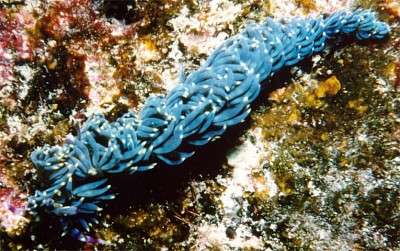
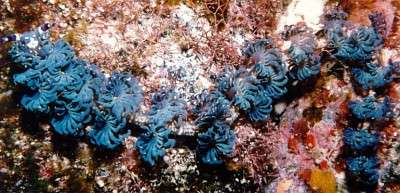
Hi Bill,
Regarding your forum discussion about the forms of Pteraeolidia ianthina, here are a couple of blue forms I photographed in Hawaii.
Happy Holidays,
Anne
adupont@gate.net
Dupont, A., 1999 (Dec 22) Pteraeolidia ianthina from Hawaii. [Message in] Sea Slug Forum. Australian Museum, Sydney. Available from http://www.seaslugforum.net/find/1701Thanks Anne,
We are certainly getting a large collection of colour forms.
Best wishes, and thanks for all your photos,
Bill Rudman
Forms of Pteraeolidia ianthina
December 10, 1999
From: C. Carlson & P.J. Hoff
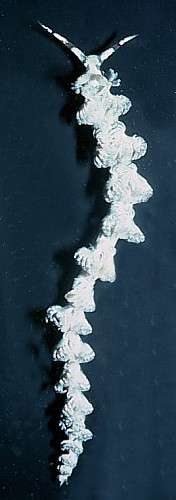
Bill,
Have you seen a Pteraeolidia ianthina of this color form? I found quite a number in Yap --usually a bit larger than the 'normal' colored forms in the same area.
Details: 65mm; Yap, Goofnuw, 12m; 1 June 1994
The white forms were found on the walls of Goofnuw channel on the north-east coast of Yap. 'Normal' colored forms were in the same area, though generally slightly smaller.
Clay & Patty Jo
clay.carlson@kuentos.guam.net
Carlson, C. & Hoff, P.J., 1999 (Dec 10) Forms of Pteraeolidia ianthina. [Message in] Sea Slug Forum. Australian Museum, Sydney. Available from http://www.seaslugforum.net/find/1649Dear Clay & Patty Jo,
I have a theory that the colour forms with a lot of opaque white are usually associated with white coral sand or rock. If this is so, I also think that camouflage is not the sole reason for the colour pattern. I think that as with Plakobranchus ocellatus, the white pigmentation cuts down the intensity of the sunlight reaching the endosymbiotic zooxanthellae so that their plastids are not 'burnt-out' by too much sunlight and so continue to photosynthesise. It's just my pet theory and I think it would be a good little hypothesis for a physiologist to test experimentally.
I assume the white in your animals is a skin pigment which masks the brown of the zooxanthellae, while the white of juvenile animals is caused by the absence of skin pigmentation and the absence of zooxanthellae.
One problem with the theory is that if the pigmentation is genetically controlled how do the larvae choose the right colour background when they settle? Or perhaps larvae don't travel very far and populations of white animals have gradually built up in 'white environments' - or perhaps it's all a load of rubbish!
Best wishes,
Bill Rudman.
Feeding? Pteraeolidia from Vanuatu
November 21, 1999
From: Vinka Stenhouse
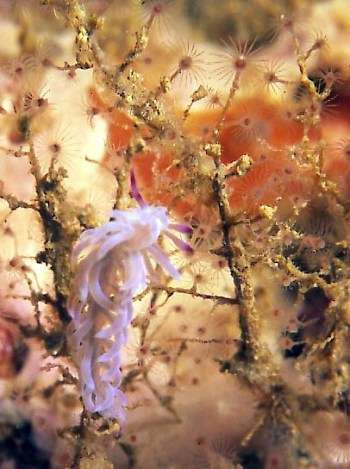
Dear Bill,
Can you identify these photos from Espiritu Santo Is., Vanuatu (1997) please? They were all found on a sea mount that is prone to currents. 13m depth.
UPPER RIGHT: 10mm long (V.Stenhouse)
LOWER LEFT: 20mm long (J.Stenhouse)
LOWER RIGHT: 18mm long (J.Stenhouse)
Yours sincerely,
Vinka Stenhouse.
Santo,
Vanuatu.
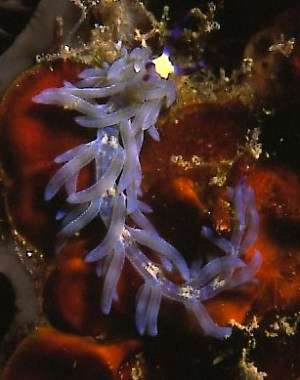
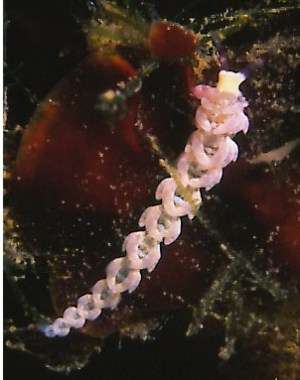
Dear Vinka,
These are all juvenile forms of Pteraeolidia ianthina. The upper photo is particularly interesting as it may be a clue to what juveniles are eating. There is a photo of an adult feeding on its preferred food, the solitary gymnoblastic tubularian hydroid Ralpharia, but despite considerable searching I have been unable to confirm what the juveniles feed on. They are often found in areas with dense growths of colonial calyptoblastic hydroids but it would make sense if they fed on gymnoblastic species. There is a special reason why it would be interesting to know what the juveniles are eating. if you look at the page on solar-powered nudibranchs you will see that adult Pteraeolidia nurtures and breeds single-celled plants (zooxanthellae) in its body, and benefits by taking some of the sugars they produce for its own nutrition. What we don't know is where it gets its first zooxanthellae from. The reason all your juveniles are white or bluish-white is that they have not yet obtained zooxanthellae. Once they do they quickly gain a brown background colour. I suspect that, like other nudibranchs with zooxanthellae, they obtain the first injection of zooxanthellae from eating a hydroid with zooxanthellae. As the large Ralpharia don't have zooxanthellae, they must get them from their juvenile food. to prove my theory I need to find the juvenile food.
Lets hope your interesting photo will lead someone to finding the answer to this puzzle.
Best wishes,
Bill Rudman.
An 'elastic' aeolid from South Africa
November 20, 1999
From: Valda Fraser
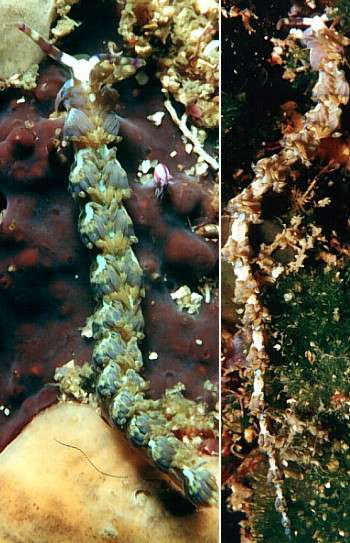
Dear Bill
This one has amazing elastic properties. One photo shows it relaxed and going about its own business. The other shows it disturbed. I hope you will be able to identify it. It is common in our area.
Locality: South Coast KwaZulu/Natal, SOUTH AFRICA. Scottburgh, Rocky reef, 24m, November 1999. Size: 780mm
Regards
Valda Fraser
Dear Valda,
This is Pteraeolidia iathina which as well as being 'elastic' is also 'solar powered', keeping single-celled zooxanthellae alive in its body where they photosynthesise and provide sugars for the nudibranch. There is some variation in shape and colour throughout the the Indo-West Pacific but I am unable to find any anatomical differences to separate them into more than one species.
Bill Rudman.
Rudman, W.B., 1999 (Nov 20). Comment on An 'elastic' aeolid from South Africa by Valda Fraser. [Message in] Sea Slug Forum. Australian Museum, Sydney. Available from http://www.seaslugforum.net/find/1548Re: Pteraeolidia from Sydney
August 18, 1999
From: Max Gillies
Elizabeth,
Just read your post 'Pteraeolidia from Sydney' on Bill's sea slug page. great shots! I've seen this guy at Fly Point in Port Stephens (best night dive in Australia for slugs I think!) as well but didn't have a camera handy. I was interested that he was at 30m as I found mine in 8m wandering over soft coral.
I could have watched it for hours (except it was turning into a drift dive as the tide had turned).
From memory he appears in 'Sea Slugs of Western Australia' with a small amount of information. I'll bring the book in tomorrow and scan the relevant sections if you're interested.
Regards
Max.
max@max.net.au
Gillies, M., 1999 (Aug 18) Re: Pteraeolidia from Sydney. [Message in] Sea Slug Forum. Australian Museum, Sydney. Available from http://www.seaslugforum.net/find/1206Dear Max,
They are quite often found on the greyish soft-coral, Parerythropodium which forms a leathery layer over sublittoral rocks. Adult Pteraeolidia feed on the large solitary hydroid Ralpharia which is found embedded in the soft-coral colonies. There is a photo of the hydroid at the Top of the Page.
Bill Rudman
Rudman, W.B., 1999 (Aug 18). Comment on Re: Pteraeolidia from Sydney by Max Gillies. [Message in] Sea Slug Forum. Australian Museum, Sydney. Available from http://www.seaslugforum.net/find/1206Re: Pteraeolidia from Sydney
August 18, 1999
From: Betsey Hansen
Stephen,
Thanks for the message. I found all of Sydney great for Sea Slugs. Unfortunately, I only spent two weeks there. I found more Sea Slugs diving there in two weeks than I have here in New York diving for ten years. I've been trying to get a transfer To Sydney to no avail.
Betsey
Elizabeth.P.Hansen@chase.com
Hansen, E.P., 1999 (Aug 18) Re: Pteraeolidia from Sydney. [Message in] Sea Slug Forum. Australian Museum, Sydney. Available from http://www.seaslugforum.net/find/1207Pteraeolidia from Sydney
August 8, 1999
From: Betsey Hansen
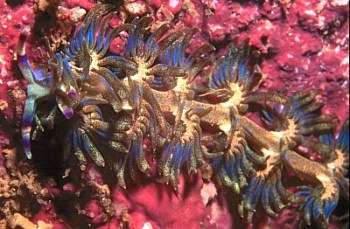
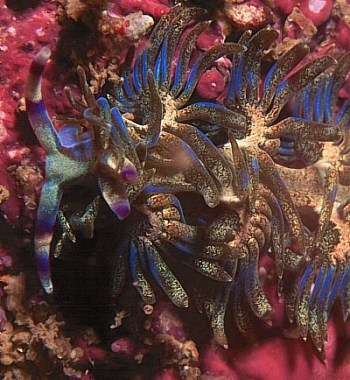
Bill,
I've search you're entire slug site and can't find this one. Don't feel bad that I went through the entire slug site without finding it, though. I thoroughly enjoy going through all the slug sites and I even learn something on occasion. I promise not to call every sea slug a nudibranch anymore. I don't know if this habit is from scuba divers or Americans, but I will try to correct my friends.
This sea slug is from your part of the world. It was taken in October 1996 on the twin anchors wreck in Manly. [Sydney, New South Wales, Australia] The depth was about 30 meters and I found it crawling across the top of the wreck. It is quite beautiful, but you don't seem to have anything close to it.
Best wishes.
Betsey
Elizabeth.P.Hansen@chase.com
Hansen, E.P., 1999 (Aug 8) Pteraeolidia from Sydney. [Message in] Sea Slug Forum. Australian Museum, Sydney. Available from http://www.seaslugforum.net/find/1152Dear Betsey,
It is a colour form of Pteraeolidia ianthina. Local divers call it the 'Blue Dragon' because of its likeness to the sinuous shape of tradiitonal Chinese dragons.
Pteraeolidia inathina is either quite variable in shape and colour or there are a number of similar species. Your photos are of a form which I felt was a distinct species, but after looking at the anatomy and radula of about 100 specimens from around the Indo-West Pacific, I can find no distinguishing anatomical features. It differs externally in the manner in which it holds the cerata in flattened hand-like clusters and the large whitish crescent shape mark on the base of each ceratal cluster.
Best wishes,
Bill Rudman.
Pteraeolidia juvenile?
February 24, 1999
From: Erwin Koehler

Bill,
Is this a juvenile Pteraeolidia ianthina? or Flabellina sp.? or something else? Red Sea, Egypt, divesite "Shark Reef ", Sept. '97, size 15mm.
Erwin
E.Koehler@deutschepost.de
Koehler, E., 1999 (Feb 24) Pteraeolidia juvenile?. [Message in] Sea Slug Forum. Australian Museum, Sydney. Available from http://www.seaslugforum.net/find/607Erwin,
Thanks for the question. It made be realise I had never added this species into the index, although you could get to it through the Solar Power page.
Yes, I'm pretty sure its a juvenile Pteraeolidia ianthina. The purple bands on the oral tentacles are fairly distinctive.
Bill Rudman.
